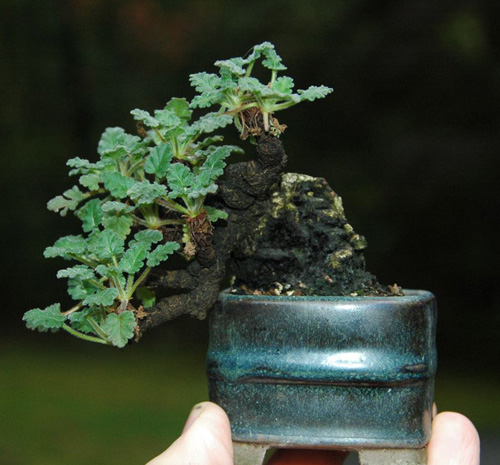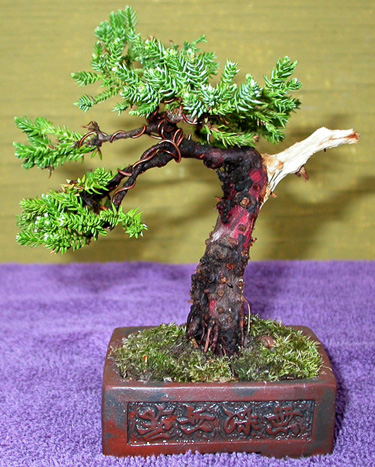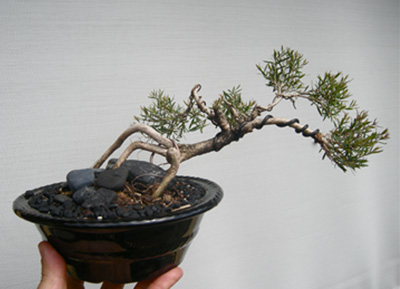 This Erodium reichardii (Heronsbill) was submitted by John Romano (this is not John’s first Bonsai Bark submission). Erodiums are in the geranium family and don’t present the styling challenges that most woody bonsai present. Still, it’s a sweet little plant and John’s pot choice is excellent.
This Erodium reichardii (Heronsbill) was submitted by John Romano (this is not John’s first Bonsai Bark submission). Erodiums are in the geranium family and don’t present the styling challenges that most woody bonsai present. Still, it’s a sweet little plant and John’s pot choice is excellent.
 This freshly styled Prostrata juniper was submitted to Stone Lantern’s $100 Unique Bonsai Contest by Alan Walker (past President, Bonsai Clubs International). It’s from a 2005 workshop with Guy Guidry, a well known American bonsai artist and teacher (photo below). Though it’s not really ready for show time in this photo, the pot is great and the tree shows plenty of potential. Specifically, the trunk has some gnarly bark, nice color and just enough taper, and and the fluid movement to the left that is offset by the powerful jin on right works well. Everything above that needs time and a well trained hand and eye. A more recent photo would be good, so we could see how the tree has progressed.
This freshly styled Prostrata juniper was submitted to Stone Lantern’s $100 Unique Bonsai Contest by Alan Walker (past President, Bonsai Clubs International). It’s from a 2005 workshop with Guy Guidry, a well known American bonsai artist and teacher (photo below). Though it’s not really ready for show time in this photo, the pot is great and the tree shows plenty of potential. Specifically, the trunk has some gnarly bark, nice color and just enough taper, and and the fluid movement to the left that is offset by the powerful jin on right works well. Everything above that needs time and a well trained hand and eye. A more recent photo would be good, so we could see how the tree has progressed.
 Why is this man so happy? (A friend looking over my shoulder just said “looks like he’s stoned” but we won’t go there). Anyway, the happy man in the photo is Guy Guidy. The little tree needs no introduction.
Why is this man so happy? (A friend looking over my shoulder just said “looks like he’s stoned” but we won’t go there). Anyway, the happy man in the photo is Guy Guidy. The little tree needs no introduction.

This entry is by Richard Warner of Brisbane. Though Richard calls it a ‘Melleluca’ (Wikipedia says ‘Melaleuca’), it looks a lot like a Dwarf myrtle (Myrtus communis compacta) to me. It may be moot, as Melaleucas are in the Myrtle family.
Richard’s comments
“Here’s an example from Australia. It’s an Australian native ‘Melleluca’, which had been in a nursery pot for too long and developed exposed roots. It needs a bit of work and time, but has some character. Once again it’s in a cheap pot.”
My comments to Richard
I agree that it has some character and also that it needs some work. If it were mine, I would consider taking off the heavy branch on the right (the one with the heavy wire). This would give the tree better taper. The exposed roots pose some problems too. Maybe you could train them over one larger rock (the bunch of little rocks don’t look very natural and are a little distracting).
Your turn. Enjoy life! Enter our $100 Unique Bonsai Contest
Thanks for the advice, I will try out your suggestions and maybe they will bear fruit in a couple of years!
This is the actual info on the plant which is very hardy.
Scientific name Melaleuca linariifolia “Claret Tops” or “Purpura Compacta”
Common name Honey–myrtle cultivar
Native to Australia
Height 0.4–1.5m
Width 1–2m
Growth rate Medium to fast
Rounded shrub with ornamental bronze–coloured new foliage. Cream flowers in spring–summer.
very lovely!